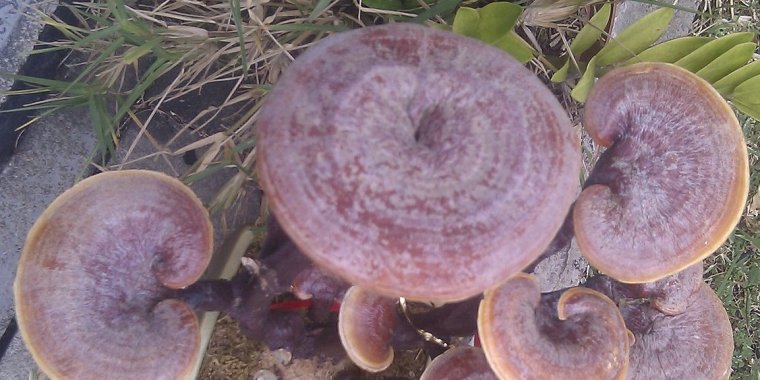| Health / Plants and plant products |
Functional and Medicinal Mushrooms
Functional mushrooms and medicinal mushrooms are often used interchangeably. They contain a diverse array of bioactive compounds that modulate immunity, inflammation, tumors, microbes, and diabetes through various cellular and molecular mechanisms. The specific activities depend on the structural features of each compound.

Reishi mushrooms. Photo: TecheOldFox, Wikipedia.
Medicinal Mushrooms
Primary Purpose: therapeutic. They have a long history in traditional medicine of various cultures. They are valued for their potential health benefits and are often used to prevent or treat specific ailments.
Bioactive Compounds:: typically rich in bioactive compounds such as polysaccharides, terpenoids, proteins, phenolic compounds.
Usage: are often consumed in concentrated forms, such as extracts or tinctures, or used to prepare teas, soups, or other traditional remedies.
Regulation: In some regions, medicinal mushrooms may be subject to more stringent regulations or requirements, especially if they are marketed with specific health claims or intended for therapeutic use.
Functional Mushrooms
Primary Purpose: they also valued for their potential health benefits but may not have as extensive a history of traditional medicinal use. They are often incorporated into diets or supplements to support overall health and well-being rather than to treat specific medical conditions.
Bioactive Compounds:: functional mushrooms also contain various bioactive compounds that may confer health benefits. However, the specific composition and concentration of these compounds can vary among different mushroom species.
Usage: commonly consumed as dietary supplements, added to foods and beverages, or used in powdered form in smoothies, capsules, or other products marketed for health and wellness purposes.
Regulation: depending on the region and how they are marketed, functional mushrooms may be subject to varying degrees of regulation. They are often marketed as dietary supplements or functional foods rather than as medicinal products.
Bioactive Compounds
Overall, while there is overlap between the two categories, medicinal mushrooms are typically associated with specific therapeutic uses and traditional medicinal practices, whereas functional mushrooms are more broadly recognized for their potential health-promoting properties in the context of modern wellness trends.
• The most important bioactive compounds are polysaccharides like α- and β-glucans. They have antitumor, immunomodulatory, antioxidant, anti-inflammatory, antimicrobial, and antidiabetic effects due to their ability to bind to cell receptors and stimulate immune responses.
• Terpenes and terpenoids also have important bioactivities including immunomodulation, anti-inflammatory, antioxidant, and antitumor properties. High levels are found in mushrooms like Ganoderma species.
• Proteins like fungal immunomodulatory proteins (FIPs) and lectins have cytotoxic, anticancer, and immunomodulatory effects through diverse mechanisms. They also facilitate cell-cell interactions.
• Other key bioactive compounds include phenolic antioxidants, laccases, and fatty acids. These have additional mechanisms including oxygen scavenging, enzyme inhibition, and immune system modulation.
Popular Medicinal and Functional Mushrooms
Reishi Mushroom (Ganoderma lucidum) also known as the “mushroom of immortality”, is one of the most well-known medicinal mushrooms, revered for its anti-inflammatory, antioxidant, antimicrobial, hepatoprotective, antiaging, antidiabetic, cardioprotective, osteoclastogenesis inhibition, antimelanogenic properties. It has been used traditionally in Asian cultures for centuries to promote longevity and overall health.
Shiitake Mushroom (Lentinula edodes) it contains compounds which have been studied for their immune-enhancing and cholesterol-lowering effects. It is also valued for its antiviral, antibacterial, and antitumor properties.
Turkey Tail Mushroom (Trametes versicolor) is rich in polysaccharopeptides (PSP) and polysaccharide-K (PSK), which have demonstrated immunomodulatory effects and potential anticancer activity. It is commonly used as an adjunct therapy in cancer treatment.
Maitake Mushroom (Grifola frondosa) contains immunomodulatory glucans, hypoglycemic polysaccharides, and cytotoxic glycoproteins. These compounds target signaling involved in immunity, apoptosis, proliferation, cell cycling, metastasis and glucose uptake.
Chaga Mushroom (Inonotus obliquus) is rich in antioxidants, including polysaccharides and phenolic compounds like betulinic acid. It is believed to have immune-boosting, anti-inflammatory, and antimicrobial properties, and is often used to support overall health and wellness.
Cordyceps Mushroom (Cordyceps sinensis) has been traditionally used in Chinese medicine for its energy-boosting and adaptogenic properties. It is believed to support endurance, vitality, and immune function, and has been studied for its potential to improve athletic performance and respiratory health.
Lion's Mane Mushroom (Hericium erinaceus) is known for its potential cognitive benefits, including improved memory, focus, and overall brain health. It contains compounds like hericenones and erinacines, which have been studied for their neuroprotective and nerve-regenerating properties.
Sources
• https://www.ncbi.nlm.nih.gov/pmc/articles/PMC7826851/
• https://en.wikipedia.org/wiki/Medicinal_uses_of_fungi
• https://www.escoffier.edu/blog/culinary-arts/what-are-functional-mushrooms-and-how-can-they-be-used/
YOU MAY ALSO LIKE





